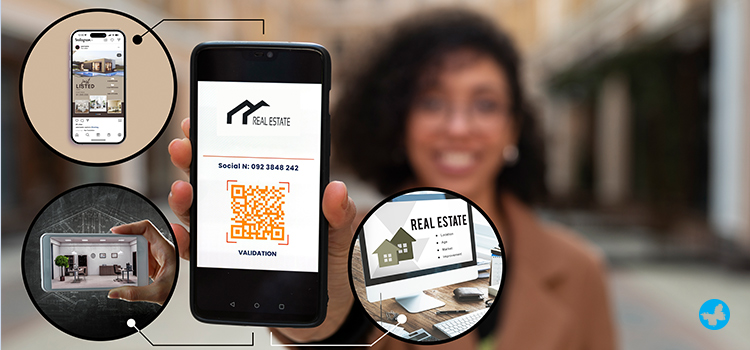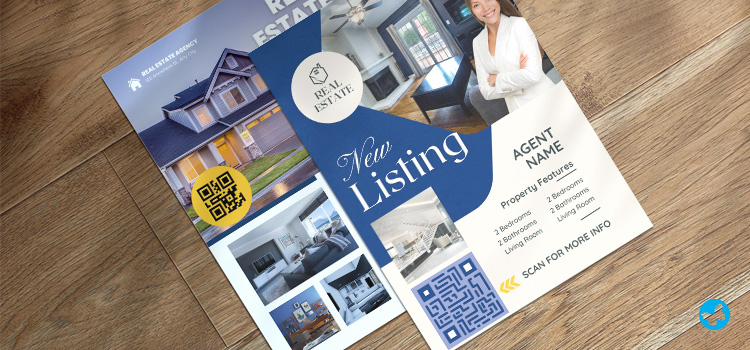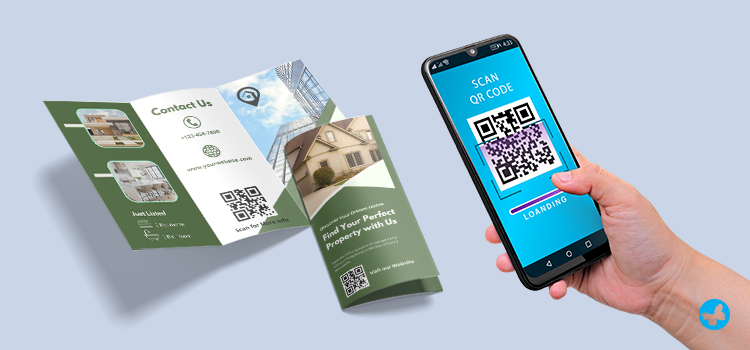For real estate professionals, keeping up with cutting-edge technological trends is now essential in the quickly changing digital landscape. QR codes, also known as Quick Response, are one integration that has been transforming the real estate market. These clever tools give users instant access to a wealth of information resources and offer a powerful way to combine the old and the new. Read this in-depth guide to learn how to use QR codes in marketing materials to their fullest potential. Let’s start by giving a brief introduction to QR codes.
What Is the Role of QR Codes in Marketing Materials?

QR codes, or two-dimensional barcodes, are digital markers that can store an impressive amount of information. When these codes are scanned using a smartphone, they swiftly direct users to a variety of digital content. Real estate agents can use QR codes in marketing materials of all kinds, from business cards to X-frame banners at trade shows.
By serving as digital gateways, QR codes link online property information and virtual experiences to printed marketing materials. They improve engagement and lead generation by streamlining the process of obtaining virtual tours, property details, and other pertinent data. This is why a QR code strategy should be a top priority for progressive real estate agents, given the rise in smartphone usage and convenience-driven consumer behaviours.
Tips to Use QR Codes for Real Estate Success
To fully utilize these digital gatekeepers, let’s now examine some efficient methods for integrating QR codes into your print real estate marketing strategy.
Provide Direct, Relevant Links
First things first, integration of QR codes in marketing materials like brochures, flyers, and postcards must be done thoughtfully. The content and context of your printed materials must be closely aligned with the landing sections of scanned QR codes. Act like a professional real estate agent who cares about every detail.
If your brochure featured a luxury property, your QR code should take the reader straight to your highly responsive contact page, a virtual tour, or comprehensive information about the property. The process of buying a home is made easier by digital connectivity that is highly relevant, builds trust with users, and keeps them excited and involved.
Match QR Code Design with Your Branding

While you embark on your QR code journey, bear in mind that code design plays a pivotal role. QR codes, typically in black and white, need to blend seamlessly with your overall design. Most QR code generators now offer customization options that let you align the QR code with your special specifications. Modify the colour scheme, include your logo, and consider the context and general aesthetic of your brand’s visual identity. This will make the user experience more unified and improve brand recognition.
Your focus should be on ensuring ease of scanning, using contrast wisely to make the QR codes visibly stand out, and strategically positioning them on your print materials.
Test QR Codes Before Printing
Testing isn’t just exclusive to software development—it applies to your print marketing materials, too. Before you place your order, ensure that the QR codes in marketing materials are functioning as expected. See that they lead the scanner to the correct URL and that the scanning process is smooth and flawless.
This preemptive assessment can save you precious time and resources, not to mention avoiding confusion or potential embarrassment. So, be careful, and definitely test the correct application of the QR code as you check other design elements.
Provide Scanning Instructions
A clear call to action and concise instructions for users who are not familiar with scanning are essential components of effective QR code scanning instructions for print marketing. “Scan for a discount” or “Scan with your phone’s camera to view the video” are two examples. Place the QR code in a noticeable spot with enough contrast, and make sure it is at least 2 cm by 2 cm so that it can be easily scanned.
Encourage Usage with Incentives
Creating an exciting element to your QR codes can increase the number of scans. Think about incorporating your QR code with special offers, like comprehensive property information or a local moving company discount.
In addition to providing potential customers with additional value, an incentive motivates them to go above and beyond by scanning the QR code and makes recipients encourage others to use it, too. Offering an incentive can make potential buyers feel valued and more inspired to scan the QR code.
Track, Analyze, and Optimize QR Codes
Use UTM parameters in combination with a URL shortener to track, analyze, and optimize QR codes in print marketing. Then, use analytics tools such as Google Analytics to track results and pinpoint areas that need improvement.
Pick a QR code generator that comes equipped with tracking features, like QR TIGER and QR Code Chimp, so that you can monitor and analyze scanning data. Understanding where your scans are coming from and which property-related QR codes command more attention can offer a wealth of insights into buyer behaviour, helping you optimize your marketing strategy.
Final Words
Like all marketing tools, real estate agents can only benefit from strategic implementation and consistent tracking when using QR codes. Connect with AgentPrint‘s expert print team, and you’ll be ready to fully harness the power of your QR codes in a real estate print marketing approach. Transforming digital opportunities into tangible marketing assets has never been easier.
Not only can you generate QR codes using your AgentPrint.com account, but our state-of-the-art printing technology ensures high-definition reproduction of QR codes on your marketing materials. Combined with our unwavering commitment to fast turnaround times and competitive pricing, we empower real estate professionals to streamline their print marketing efforts in the digital age.
